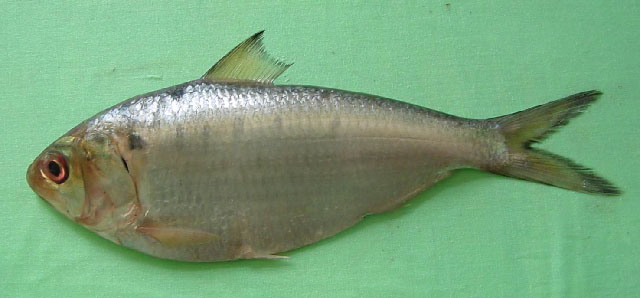| Dorosomatidae (Gizzard shads and sardinellas) |
| 35 cm TL (male/unsexed) |
|
pelagic-neritic; freshwater; brackish; marine; depth range - 10 m, anadromous |
| Indo-West Pacific: probably all coasts of Indian Ocean, from Gulf of Oman and Gulf of Aden south to Durban and Madagascar, across the Bay of Bengal, Gulf of Thailand, Java Sea and north to Hong Kong and east to Papua New Guinea and possibly further (Ref. 188). |
|
Dorsal spines (total): 0-0; Dorsal soft rays (total): 16-19; Anal spines: 0-0; Anal soft rays: 17-23. Diagnosis: Body fairly deep and compressed, belly with distinct keel of scutes; top of head with numerous fronto-parietal striae; upper jaw with median notch; gillrakers about 100 to 175, those on inner arches distinctly curled; outer row of gill filaments on first arch not more than half length of gillrakers; a series of small triangular scales above axil of pectoral fin; hind part of body scales perforated (Ref. 188). A black spot behind gill cover, usually followed by up to 10 spots along flank (Ref. 188).
Description: Body fusiform, fairly deep and compressed; belly with a distinct keel of scutes (Ref. 3107). Top of head with numerous, 8-14, fronto-parietal striae; upper jaw with a distinct median notch; 2 supramaxillae present (Ref. 188, 3107, 3259, 30573). Gillrakers very fine and numerous, 75-175 on lower limb of first gill arch, those on inner arches curled; number increasing with growth (Ref. 3107, 3259). Dorsal fin origin a little before mid-point of body; anal fin short and well behind dorsal fin base; dorsal fin with 3-4 unbranched and 13-15 branched rays, anal fin with 2-4 unbranched and 15-19 branched rays, pectoral fin with 1 unbranched and 12-15 branched rays, pelvic fin with 1 unbranched and 7 branched rays (Ref. 3107, 3259). Scales on longitudinal series 39-44; posterior part of scales with perforations (Ref. 3107, 3259). Sharp keeled scutes present along belly; with 15-17 pre-pelvic scutes and 12-14 post-pelvic scutes (Ref. 28, 3259).
Colouration: Back blue-green, flanks silvery with a black spot behind gill opening and up to 10 similar spots along flanks, or high up near dorsal profile (Ref. 188, 3107, 3259, 12484). |
| Found in coastal waters (Ref. 3107, 30573); marine, pelagic, but entering estuaries and able to tolerate quite low salinities (7 ppt) (Ref. 188). Feeds chiefly on phytoplankton, mainly diatoms, also dinoflagellates, but also copepods, molluscan and crustacean larvae, prawns, amphipods and polychaetes (Ref. 188). Spawns, at least in Godavari estuary, around February (Ref. 188). Marketed fresh, dried, dried-salted and boiled. Made into fish balls. |
|
Least Concern (LC); Date assessed: 11 July 2018 Ref. (130435)
|
| harmless |
Source and more info: www.fishbase.org. For personal, classroom, and other internal use only. Not for publication.
